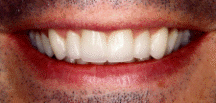A crown is a dental restoration that covers your entire tooth. It used to be that any crown had to have some metal in it for strength. Today, we can make them out of all porcelain, meaning that they can look very esthetic and very natural. Unfortunately, dental schools emphasize the use of porcelain fused to metal crowns, and that’s the only crown many dentists know how to do for front teeth. But porcelain fused to metal crowns for front teeth look opaque, unnatural, 
Dental Crown Choices for Front Teeth
A dental crown on a front tooth is needed when either a good portion of the tooth is gone or a good portion of the biting edge is gone—there are large old fillings, a tooth fracture, or a large area of tooth decay. A filling is used when a small portion of the tooth is damaged, a crown when the tooth has extensive damage. And there are three basic categories of crowns for front teeth: bonded all porcelain, extra strength all ceramic, or porcelain fused to metal.
- Bonded All Porcelain – This is the type of crown that looks the most natural and which I recommend for a front tooth. It is made entirely of porcelain or other ceramic material. The porcelain itself is not very strong. The restoration gets its strength by bonding it to the tooth. However, many dentists are not trained in the bonding techniques required to place these crowns, so you should be careful to only have them done by expert cosmetic dentists. For information on locating an expert cosmetic dentist in your area, please see our referral page.
This type of crown has the nicest appearance. It mimics the appearance of nature to the point where it is difficult to tell that it is not a natural tooth. An all porcelain crown costs more than a porcelain fused to metal crown. And while an all porcelain crown is strong enough for front teeth, it may not be strong enough for some back teeth in some patients with an extra strong bite. - Extra Strength All Ceramic – There are some new ceramic materials that have extra strength – so much so that they don’t have to be bonded. Some general dentists like to place these crowns on front teeth because they don’t require specialized training to place, and they don’t have the esthetic disadvantages of metal. However, they might not be quite as esthetic as the bonded all porcelain crowns. Some brand names of crowns that are this type are Procera crowns, InCeram crowns, Lava crowns, and CEREC crowns. They have a white core, not an opaque metal core. With some of them, that is an opaque white core, which can compromise the esthetics. They don’t tend to develop the dark black line at the gumline that porcelain fused to metal crowns do, but they can still reveal a sharp color difference where the crown meets the tooth. Some of them can be a little more abrasive on the opposing teeth that chew against them. Zirconia is another high-strength ceramic, and Zirconia crowns can be made translucent. If they are bonded onto the teeth they won’t show a dark line.
- e.max crowns – While this is an extra-strength all-ceramic crown, I put it in a separate category because of its exceptional esthetics. It consists of a core of lithium disilicate, which is a high-strength ceramic, which is then veneered with porcelain. While it may not be strong enough to survive exceptionally heavy biting stresses, it is strong enough so that it can be cemented with conventional techniques and can have a life-like appearance when placed on a front tooth.
- Porcelain Fused to Metal – Porcelain fused to metal crowns, for general dentists who aren’t passionate about appearance, look “good enough.” But even many lay people can tell when friends have this type of crown on front teeth. They tend to have a very fake-looking opacity, and they will tend to get a black line at the gumline after a few years. This line may not show when the crown is first placed but shows later, as the gum recedes. But porcelain fused to metal is substantially stronger than the all porcelain crown. The biggest advantage for general dentists is that this crown is much easier to place. A competent general dentist with only the training received in dental school can correctly place one of these crowns.
Here is a beautiful case of all-porcelain crowns on a media personality done by mynewsmile dentist Dr. Ross Headley of Overland Park, Kansas. For more information on Dr. Headley, click here.
—Dr. David Hall.
Click here to ask Dr. Hall a question.
Related information:
- Read about the loss of enamel on the insides of the front teeth from bulimia.
- Dinah from Miami asks if it’s realistic to expect a perfect color match for a porcelain crown on a front tooth.
- Read Dr. Hall’s blog posts about porcelain crowns for front teeth, where he answers questions from patients.


